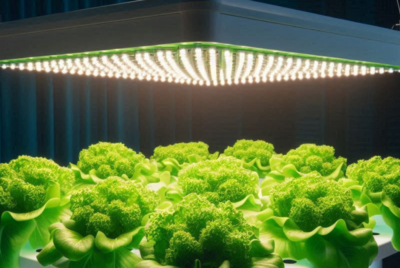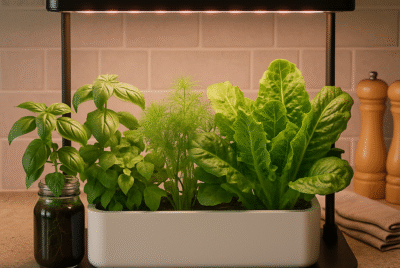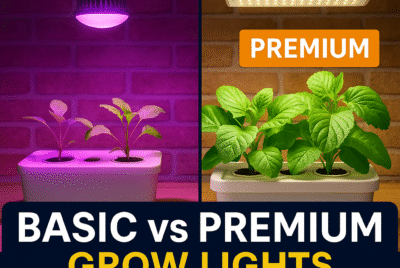Grow Hydroponic Seeds Fast
Are you ready to learn the secrets of growing hydroponic seeds and reaping the benefits of this innovative gardening method? In this article, I will guide you through the process of growing hydroponic seeds, step by step.
Discover the numerous advantages of hydroponic seed gardening and gain valuable insights into selecting the right seeds, setting up your hydroponic system, nurturing your plants, and harvesting the fruits of your labor. Make sure you have done some research on using the best Hydroponic Kit. Let’s dive in!
Understanding Hydroponic Seeds Gardening
Hydroponic seed gardening is a soil-less cultivation method that harnesses the power of water and nutrients to grow healthy and vibrant plants. The benefits of this approach are remarkable and include:
Benefits of Hydroponic Seeds Gardening
- Optimal Nutrient Absorption: With hydroponic seed gardening, plants receive nutrients directly in the water, ensuring they have access to the perfect balance of nourishment. This leads to faster growth, larger yields, and healthier plants.
- Water Conservation: On contrast, hydroponic systems use up to 90% less water compared to traditional soil gardening. The water is recirculated, reducing waste and promoting sustainability.
- Year-Round Growing: Unlike traditional gardening, hydroponic seed gardening allows you to grow plants year-round, regardless of the season. Say goodbye to long winters without fresh produce!
- Space Efficiency: Hydroponic systems are space-efficient, making them ideal for urban gardeners or those with limited outdoor space. Vertical growing systems maximize the use of vertical space, allowing you to grow more plants in a smaller footprint.
Now that we understand the benefits, let’s delve into the process of growing hydroponic seeds and explore the steps involved.
SIX STEPS
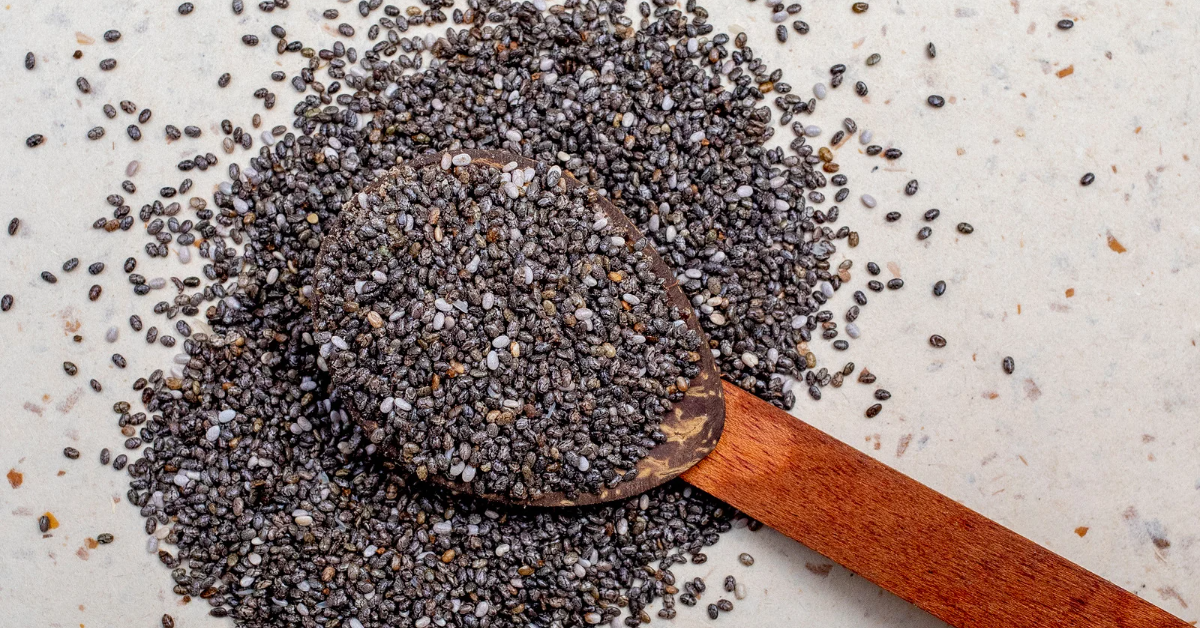
1. Choosing the Right Hydroponic Seeds
Selecting the right seeds is a critical first step in successful hydroponic seed gardening. Consider the following factors when choosing seeds for your hydroponic garden:
- Variety Selection: Choose seeds that are suitable for hydroponic cultivation. Certain plants, such as leafy greens, herbs, and compact vegetables, thrive in hydroponic systems.
- Seed Quality: Opt for high-quality seeds from reputable sources. Look for seeds that have a high germination rate and are specifically labeled for hydroponic or greenhouse use.
- Crop Suitability: Determine the crops you want to grow and ensure they are well-suited for hydroponic cultivation. Research the specific requirements and preferences of each plant.
Once you have selected your seeds, it’s time to set up your hydroponic system.
2. Settings: Ensure maximum growth of hydroponic seeds
Setting Up Your Hydroponic System
The first step to growing hydroponic seeds is setting up your hydroponic system. There are several types of systems, including Deep Water Culture (DWC), Nutrient Film Technique (NFT), and Ebb and Flow systems. The choice of system will depend on the types of plants you’re growing, the space you have, and your budget.
1. Deep Water Culture (DWC) system is a simple and effective setup. It involves suspending plant roots in a nutrient-rich water solution.
2. The Nutrient Film Technique (NFT) is another popular system, where a thin film of nutrient solution flows over the roots, providing oxygen and nutrients.
3. An Ebb and Flow system works by flooding the plant roots with nutrient solution periodically and then draining it away, simulating natural water cycles.
4: For those with limited space, a vertical hydroponic system can maximize growing area by stacking plants in a tower structure.
5. If you prefer a ready-made solution, consider investing in a complete hydroponic kit, which includes everything you need to get started, from the system to the nutrients and seeds.
Types of Hydroponic Systems
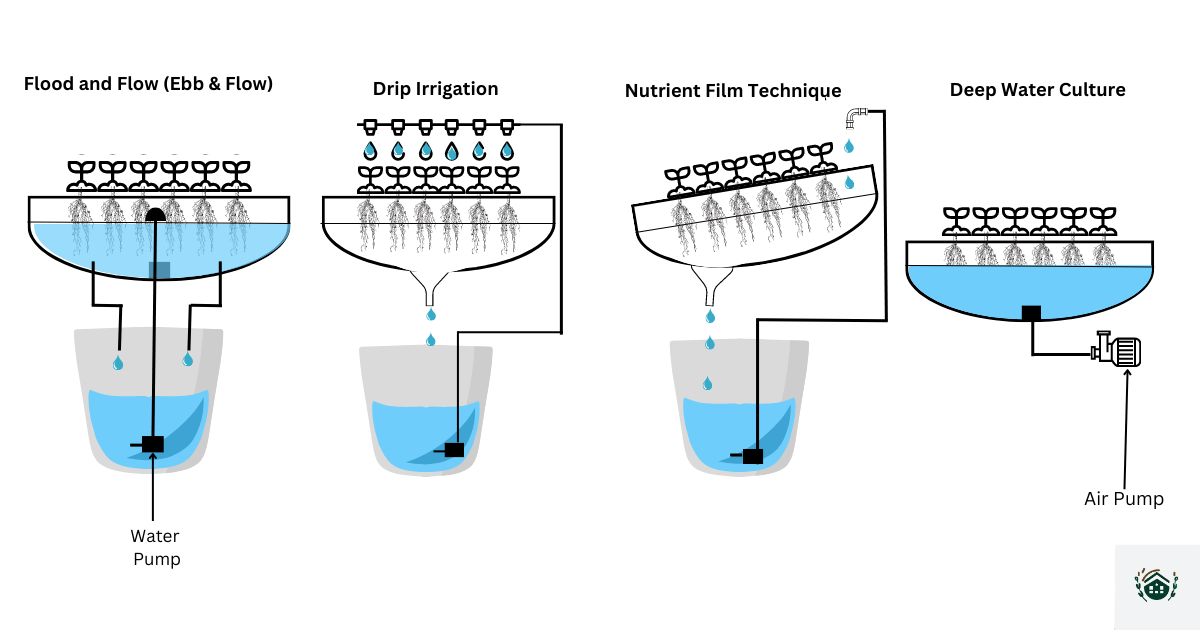
To ensure successful growth of your hydroponic seeds, it’s crucial to set up your hydroponic system properly. Consider the following factors:
Selecting the Appropriate Growing Medium
- Inert vs. Non-Inert: Choose between inert and non-inert growing mediums. Consider Inert mediums, such as perlite or rockwool, do not provide any nutritional value but offer excellent support for the roots. Non-inert mediums, like coconut coir or vermiculite, provide both support and some nutrient content.
- Moisture Retention: Consider the moisture retention capabilities of the growing medium. It should hold enough water for the roots to absorb, but also allow for proper drainage to prevent overwatering.
Providing Adequate Hydroponic Grow Lights
- Light Spectrum: Choose the appropriate light spectrum for your plants’ growth stages. Seedlings require blue spectrum lights for vegetative growth, while flowering plants benefit from red spectrum lights.
- Light Intensity and Duration: Provide sufficient light intensity and duration to mimic natural sunlight. Most plants need 12-16 hours of light per day during the vegetative stage and 8-12 hours during the flowering stage.
Maintaining Optimal Temperature and Humidity
- Temperature Control: Maintain the ideal temperature range for your plants. Most hydroponic crops thrive in temperatures between 65-75°F (18-24°C) during the day and 55-65°F (13-18°C) at night.
- Humidity Regulation: Monitor and regulate humidity levels to prevent issues like mold or fungal growth. Aim for a humidity range of 40-60% for most plants.
With your hydroponic system set up, it’s time to move on to germinating your hydroponic seeds.
3. Germinating Hydroponic Seeds
Germination is the process by which a seed sprouts and starts developing into a seedling. Follow these steps to ensure successful germination of your hydroponic seeds:
- Seed Preparation: Soak the seeds in water for the recommended time to kickstart the germination process.
- Germination Medium: Use a suitable germination medium such as paper towels, peat pellets, or rockwool cubes. Place the seeds in the medium and keep it moist.
- Warmth and Moisture: Maintain a warm and moist environment for the seeds to germinate. A temperature range of 70-80°F (21-27°C) is ideal.
- Provide Light: Once the seeds have sprouted, place them under appropriate lighting to promote healthy growth.
Once your seeds have germinated and developed into seedlings, it’s time to transplant them into your hydroponic system. Find journal reference to germination on slant boards.
4. Transplanting Seedlings
Transplanting seedlings is a critical step in hydroponic seed gardening. Follow these guidelines for successful transplantation:
- Seedling Development: Wait until the seedlings have developed a strong root system and are at least 2-3 inches tall before transplanting.
- Gentle Handling: Handle the seedlings with care to avoid damaging the delicate roots, by ensuring you hold the seedling by the leaves to avoid stem damage when transplanting.
- Proper Placement: Position the seedling in the growing medium of your hydroponic system, ensuring that the roots are adequately covered and supported.
- Watering: After transplanting, water the seedlings gently to settle the growing medium and ensure the roots make good contact with it.
Now that your seedlings are transplanted, it’s essential to provide them with the right nutrient balance for healthy growth.
5. Nutrient Management for seedlings
In a hydroponic system, nutrient management plays a vital role in supporting the growth and development of your seedlings. Follow these tips to ensure proper nutrient supply:
- Select a Balanced Nutrient Solution: Choose a hydroponic nutrient solution specifically formulated for seedlings. These solutions contain the essential macronutrients (nitrogen, phosphorus, and potassium) and micronutrients required for healthy plant growth.
- Monitor pH Levels: Regularly check the pH level of your nutrient solution using a pH meter or pH test kit. Most seedlings prefer a slightly acidic pH range between 5.5 and 6.5. Adjust the pH if necessary by adding pH-up or pH-down solutions.
- Maintain Proper EC Levels: Electrical conductivity (EC) is a measure of the nutrient concentration in the solution. Use an EC meter to monitor and maintain the appropriate nutrient strength for your seedlings. Follow the manufacturer’s instructions for the recommended EC range.
- Feeding Schedule: Establish a feeding schedule based on the specific nutrient requirements of your seedlings. Start with a diluted nutrient solution and gradually increase its strength as the seedlings mature. Nutrients can be the form of Hydroponic Fertilizer or other organic nutrients. I encourage you to follow the manufacturer’s guidelines along with the plants needs. Over feed could affect growth.
Remember to regularly monitor the nutrient solution, adjust pH and EC levels as needed, and provide your seedlings with a balanced and consistent nutrient supply.
6. Providing Proper Care and Maintenance: Hydroponic Seeds
To ensure healthy growth and maximize the yield of your hydroponic seedlings, it’s essential to provide proper care and maintenance throughout their growth cycle. Consider the following aspects:
Watering and Monitoring pH Levels
- Watering Frequency: Monitor the moisture levels in the growing medium and water your seedlings as needed. Avoid overwatering, as it can lead to root rot and other problems. Ensure proper drainage in your system.
- pH Monitoring: Regularly check and maintain the pH levels of the nutrient solution to ensure optimal nutrient absorption by the plants. Fluctuations in pH can affect nutrient availability and plant health.
Pruning and Training
- Pruning: Remove any dead or diseased leaves or stems from your seedlings to maintain overall plant health. Pruning also helps improve airflow and reduces the risk of pests and diseases.
- Training: Train your plants by gently guiding their growth to promote better light penetration and airflow. This can be done through techniques like topping, trellising, or using plant clips.
Preventing Pests and Diseases
- Hygiene and Sanitation: Maintain a clean and sterile environment in your hydroponic system. Regularly clean and disinfect equipment, trays, and growing surfaces to prevent the buildup of pests and diseases.
- Monitor for Pests: Regularly inspect your seedlings for signs of pests such as aphids, mites, or whiteflies. In a case were you see insets starting, I recommend the use of appropriate pest control measures, such as introducing beneficial insects or using organic insecticides if necessary.
With proper care and maintenance, your hydroponic seedlings will flourish and be ready for a bountiful harvest.
Harvesting and Enjoying Your Hydroponic Produce
Make sure to follow these guidelines for successful harvest:
- Harvesting Time: Each crop has its specific harvesting time. Monitor the maturity
of your plants by observing factors like size, color, and taste. Harvest your produce at the peak of freshness. - Proper Harvesting Technique: Use clean and sharp tools to harvest your hydroponic
crops. Cut the plants at the base, ensuring minimal damage to neighboring plants. - Post-Harvest Handling: Immediately after harvest, rinse your produce gently to
remove any debris. Properly store or consume the harvested produce to maintain its freshness and quality. - Enjoying the Fruits of Your Labor: Now comes the most rewarding part—enjoying the fresh, nutritious, and flavorful produce from your hydroponic garden! Incorporate your homegrown herbs, leafy greens, or vegetables into your meals, salads, or smoothies for a truly farm-to-table experience.
So to conclude, make sure you follow these steps by providing the necessary care and attention, you can successfully grow hydroponic seeds. Above all, you will get to enjoy a continuous supply of fresh and healthy produce throughout the year.
Top 3 Recommended Hydroponic Seeds
When it comes to purchasing hydroponic seeds, Amazon offers a wide range of options that cater to different types of plants. Below are five top-rated hydroponic seed products available on Amazon, each selected for their high germination rates, suitability for hydroponic systems, and customer satisfaction.
1. Leafy Green Mix – Sereniseed Artful Gardening.
If you’re looking to grow a vibrant mix of leafy greens, the Sereniseed Artful Gardening Herb Mix is a fantastic option. This mix includes a variety of fast-growing, nutrient-packed greens that are perfect for salads, smoothies, or garnishes.
Varieties Included:
This mix typically includes
Varities of thym, Italian oregano, caribe cilantro, Lavender, dill, basil chives and more, providing a diverse harvest with different textures and flavors.
Germination Rate:
Over 95% germination rate, ensuring a bountiful crop.
Hydroponic Suitability:
These seeds are particularly well-suited for NFT and DWC systems, thriving in a water-based environment with nutrient film and constant moisture.
Customer Ratings:
Highly rated on Amazon . Customers praise the rapid growth and vibrant colors of the greens.
2. Herb Variety Pack – Sustainable Seed Company
Herbs are a must-have in any hydroponic garden, and the Sustainable Seed Company Herb Variety Pack offers an excellent selection for beginners and experienced gardeners alike.
Varieties Included:
This pack includes basil, cilantro, parsley, thyme, and dill, giving you a versatile herb garden for culinary use.
Germination Rate:
Approximately 90% germination rate, which is impressive for a variety pack.
Hydroponic Suitability:
Ideal for small-scale systems like aeroponics or Kratky method setups, these herbs don’t require much space and can thrive with minimal intervention.
Customer Ratings:
With a high star rating and numerous positive reviews, this herb pack is a favorite among hydroponic growers for its consistent results and robust flavors.
3. Variety Mix Hydroponic Seeds – The Sprout House
For gardeners looking to try something a bit different, the Mix Hydroponic Seeds Pack by The Sprout House offers a unique selection of plants not commonly found in traditional gardens.
– Varieties Included: This pack includes seeds for Mix plants like salad mix, Broccoli, Bean salad, Red clover and more, bringing an international flair to your hydroponic garden.
– Germination Rate: Typically around 80%, which is quite good for exotic species that might be more challenging to grow.
– Hydroponic Suitability: These seeds are perfect for deep water culture and ebb and flow systems, where consistent moisture and nutrients can be easily maintained.
– Customer Ratings: With a 4.2 out of 5-star rating, customers love the uniqueness and vibrant flavors of the plants grown from these seeds.
5 Top Hydroponic systems to consider
1. Space Efficiency
One of the main reasons people opt for vertical hydroponic systems is because they’re incredibly space-efficient. If you live in an apartment or have a small backyard, traditional gardening might not be feasible. However, with a vertical system, you can grow a large number of plants in a very compact area.
Aerogarden Farm 24Plus
I’ve personally used the Aerogarden Farm 24Plus, and it’s a fantastic option if space is a concern. It’s a bit on the pricier side, but the ability to grow up to 24 plants in just 2 square feet is worth it.
2. Water Conservation
Traditional soil gardening often requires a significant amount of water, much of which is lost due to evaporation or runoff. Vertical hydroponic systems, on the other hand, are designed to recirculate water, making them far more water-efficient. This is not only better for the environment but also reduces your water bill.
iDOO Hydroponics Growing System
The iDOO Hydroponics Growing System is an excellent choice if you’re looking for something that’s water-efficient. It has a smart water circulation system that ensures your plants get the nutrients they need without wasting water.
3. High Yield and Rapid Growth
Another significant benefit of vertical hydroponic systems is that they often produce higher yields compared to traditional gardening. The nutrient-rich water provides plants with exactly what they need to grow quickly and healthily. This means you can enjoy fresh produce faster than you would with soil gardening.
Nutraponics Vertical Hydroponic Garden Tower
The Nutraponics Vertical Hydroponic Garden Tower is a powerful system that supports rapid plant growth. I’ve seen firsthand how quickly my herbs and lettuce grew using this system.
4. Year-Round Gardening
One of the most appealing aspects of hydroponics is the ability to grow plants year-round. Because these systems are often used indoors or in controlled environments, you’re not limited by the seasons. This is perfect for those who want to enjoy fresh vegetables and herbs no matter the time of year.
VegeBox Home Indoor Hydroponics Growing System
The VegeBox system is perfect for year-round gardening. It comes with full-spectrum LED lights that mimic natural sunlight, ensuring your plants thrive even in the dead of winter.
5. Minimal Pests and Diseases
Since hydroponic systems don’t use soil, you’re less likely to deal with soil-borne pests and diseases. This can save you a lot of headaches and make gardening a much more enjoyable experience.
Gardyn 2.0 Home Kit
The Gardyn 2.0 is an innovative hydroponic system that’s designed to minimize pests and diseases. It uses AI technology to monitor plant health and automatically adjust the environment for optimal growth.
Closing remarks
Congratulations on completing this comprehensive guide to growing hydroponic seeds! We’ve explored the benefits of hydroponic seed gardening, from optimal nutrient absorption and water conservation to year-round growing and space efficiency. By choosing the right seeds, setting up your hydroponic system correctly, germinating the seeds, transplanting seedlings, managing nutrients, and providing proper care, you can cultivate thriving plants and harvest an abundance of flavorful produce.
In conclusion, hydroponic seed gardening will offer you a sustainable and efficient approach to gardening, allowing you to enjoy the pleasures of gardening regardless of limited space or challenging weather conditions. So, why not embark on this exciting journey and experience the joy of growing your own hydroponic garden!
FAQs: Hydroponic Seeds
1. Can I use any type of seeds for hydroponic gardening?
A: While many seeds can be used, it’s best to choose varieties that are well-suited for hydroponic cultivation, such as leafy greens, herbs, and compact vegetables.
2. Do hydroponic seedlings require any special care compared to traditional gardening?
Hydroponic seedlings require regular monitoring of nutrient levels, pH, and water. However, they also benefit from a controlled environment that minimizes pests and diseases.
3. How long does it take for hydroponic seeds to germinate?
Germination times vary depending on the plant species and environmental conditions. Generally, hydroponic seeds germinate faster than traditional soil-based seeds.
4. Can I reuse the nutrient solution for multiple seedlings?
It’s recommended to refresh the nutrient solution periodically to maintain its balance and prevent nutrient depletion. Fresh nutrient solutions ensure optimal growth and health for your seedlings.
5. Are hydroponic plants as nutritious as soil-grown plants?
Yes, hydroponic plants can be equally, if not more, nutritious than soil-grown plants. With the required control over nutrient intake, hydroponic plants can have optimized nutrient profiles.
Remember, experimenting and learning from your own experiences is an integral part of hydroponic gardening. Embrace the journey, adapt to the needs of your plants, and enjoy the satisfaction of growing your own hydroponic garden!
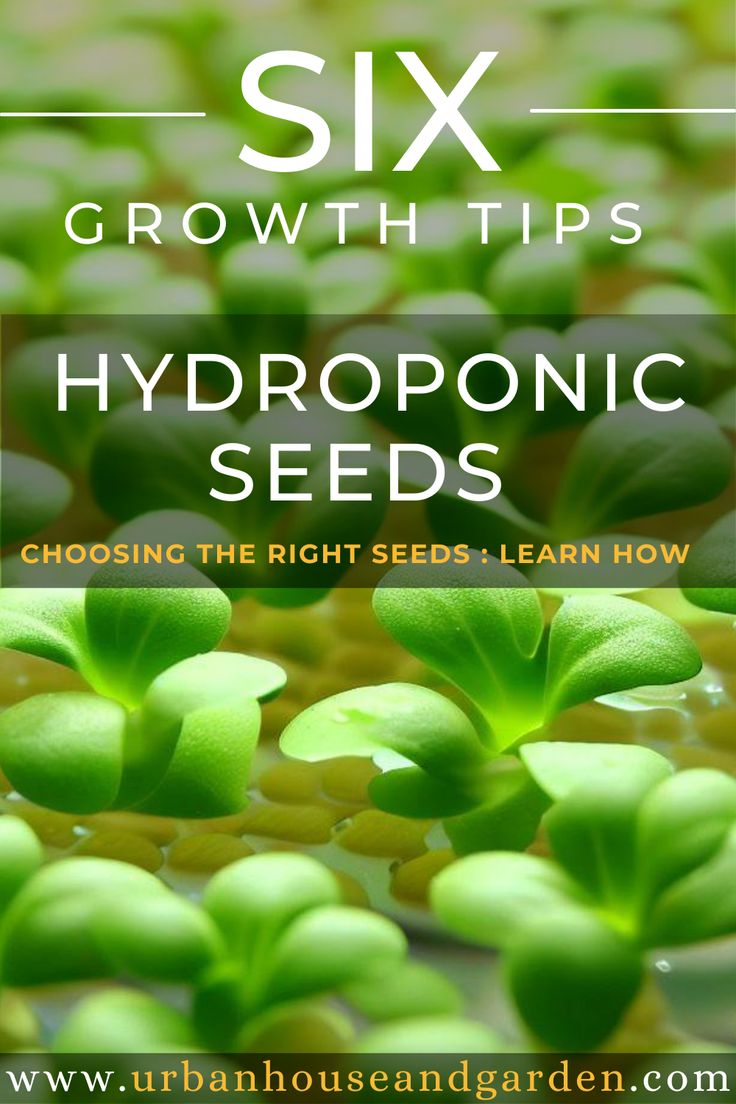
*We may earn a commission from purchases made through our links, at no cost to you. This does not affect our product recommendations. Please see our disclosure to learn more.


